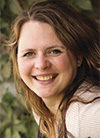I knew this conversation during milking was going to happen eventually, but when it did, I was not totally prepared. “I think Beth needs to go on the truck,” my husband, Sam, said during Tuesday morning milking. He was referring to Beth, who was the oldest cow in the barn and occupied stall number 45 for as long as I could remember.
“Are you sure you don’t want to wait until we start calving more replacements in?” I asked. I nodded toward Beth’s daughter across our stall barn, bagging up in preparation for her first calf due in a few weeks. After doing some very heavy culling in 2016 and 2017, I was hesitant to do any more even though I could see this day coming.
“What she’s milking right now isn’t paying her bills,” Sam said.
I looked at the old cow whose mind and spirit were still sharp as ever even though her body was failing her.
“Another calving just might kill her too,” I realized aloud. Since we were toward the end of milking, I kept a close eye on the cows while Sam went and called our cattle hauler, who said he’d pick her up on Thursday.
While dairy farming is as much a business as it is a way of life, those business decisions have deep emotional ramifications at times and can cut like a knife. What cut into the quick even more for me was remembering that Beth wasn’t always this way.
Beth was the queen of the herd for several consecutive years, and she absolutely knew it. She was definitely our iron lady, out-milking every single one of the cows on test day when she was hitting her peak. She was a brassy old battle-ax too; she was not even remotely affectionate, and it would have been a stretch to call her friendly. She respected us and we respected her, but we knew she was the boss. More than anything, she just wanted to eat, be milked and do her job.
Even more remarkable was the impact she had on our herd. On top of her outstanding will to milk, she was a beautiful cow in her prime too, with plenty of width and depth to go around in addition to her uphill run. Her one conformational downfall would be her feet and legs, which was the Achilles’ heel (literally) of her maternal line. If she didn’t bless us with heifer calves, her sons were automatically in the running to serve as jumper bulls for our heifers, giving us granddaughters and great-granddaughters.
Last year, Beth was supposed to be coming into what we thought would be her best record yet. It was a cold and snowy Sunday morning, and we were hurrying through chores to get in the warm and cozy house to get cleaned up for church when we saw that she was in labor. After finishing milking around 7 a.m., we decided in about an hour that we’d come back and check on her in the barn.
In that hour, she had not only delivered an absolutely gorgeous High Octane heifer calf, but she had somehow injured and sliced one of her teats from udder to teat end. Looking back now in my mind, it was the beginning of the end. She ended up developing a runaway case of mastitis in that quarter that ended up being more costly to treat than it was to just dry up that quarter and milk her on the other three. Then, as was the means to an end for others in her cow family, her feet started to give out, and this was greatly exacerbated this year after a rough delivery with a large bull calf.
It got tougher and tougher to watch her slowly amble down the barn walk and out the door, only to watch her herdmates practically run past her to jump and skip down the lane out to the paddocks after each milking. We could practically hear her lamenting how her body had failed her. While milking one night not so long ago, I looked at her and asked, “Well, old girl, do you think you’ve got one more lactation in you?” She looked at me and I swore I could hear her sigh.
After I finished milking that Tuesday morning and Sam had made arrangements with the cattle hauler, I vented the line and made sure no one was around before snuggling up with that very pregnant daughter of old Beth across the barn and quietly shedding a few tears while years and years of memories came rushing back. I grabbed a paper towel, wiped my face off, and got back to work.
I don’t know if I’ll be around to help load her on the trailer when the hauler backs down our driveway. I can’t even stand to look cows in the eye when we ship them, especially when I think about people loading their entire herds on trailers to leave and never come back, and the welling of tears in my eyes as I finish this post tells me that this one might hit a little harder. As time goes by and more of her descendants start to calve in, those sad sighs will instead become smiles as we begin to see remnants of our old iron lady shining through.
Like Winnie the Pooh once said, “How lucky I am to have something that makes saying goodbye so hard.”
Bye-bye, Beth. Thank you for everything. ![]()
Brittany Olson is a dairy farmer and freelance writer from Chetek, Wisconsin. She and her husband, Sam, milk 40 registered Holsteins and Jerseys on their 116-year-old farm.
PHOTO: Sam and Brittany Olson considered Beth to be the queen of their herd for several years. Photo by Brittany Olson.







